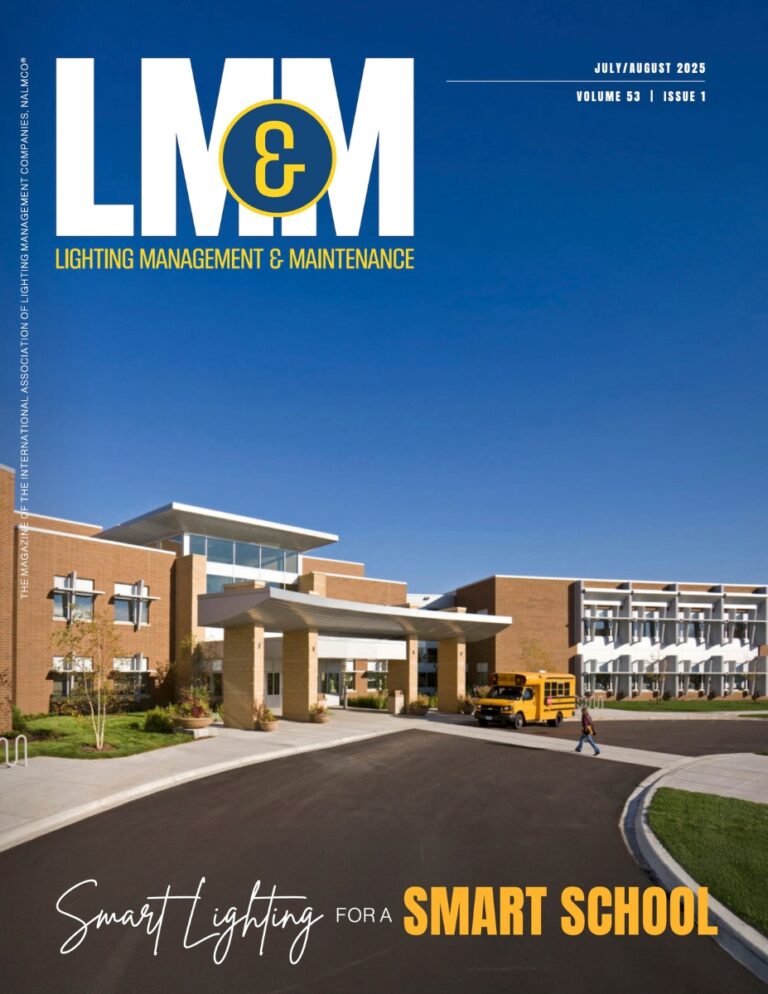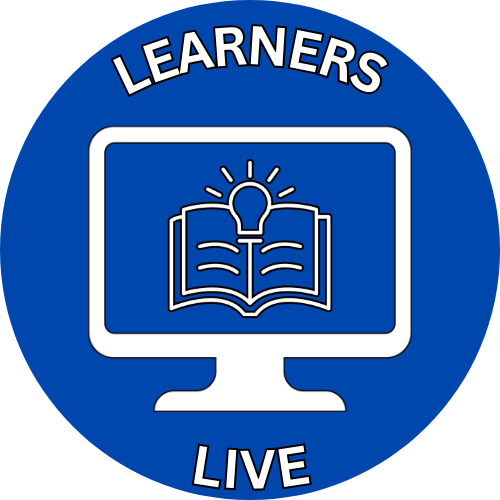David Radulescu, Ph.D., Founder and Partner of Radulescu LLP, an elite patent litigation boutique firm based in New York City, delivered a comprehensive webinar on the state of the playing field for solid-state lighting and patent litigation on February 16, 2022. The field of play more closely resembles liquefaction than the frozen tundra of Lambeau Field.
David Radulescu has for many years spoken on patent issues facing the LED lighting industry during LightFair. These privately hosted meetings have been well-attended by LED lighting companies interested in learning more about the increasing threat of patent litigation to their businesses. Because of the postponement of LightFair 2020 and other industry conferences due to COVID-19, Dr. Radulescu and his firm have moved the annual talk online.
The webinar was neatly packaged into 5 segments:
- Recent Trends in U.S. Patent Litigation in the LED Industry
- The LED Patent Litigation Landscape
- Update on the Signify EnabLED Licensing Program
- Status of other LED Licensing programs
- Non-Practicing Update
Dr. Radulescu first reviewed trends in LED patents and patent litigation in the United States.
After hitting another 10-year high in 2020, U.S. patent grants declined by 7.5% in 2021. 2021 saw a decrease in grants from U.S. and Japanese inventors, and an increase in grants to Chinese inventors. LED patent grants are down for the second year in a row from an all-time high in 2019 for the first time since 1983. Patent issuance in the U.S. was slightly down in 2021. This is contributed to by the fact that the top three countries who have ownership of U.S. Patents dropped, as with most of the Top 10, with the only country seeing an increase in 2021 from 2020 being China, who is presently 4th and close to overtaking South Korea for 3rd but far back from #1 U.S.A. and # 2 Japan.
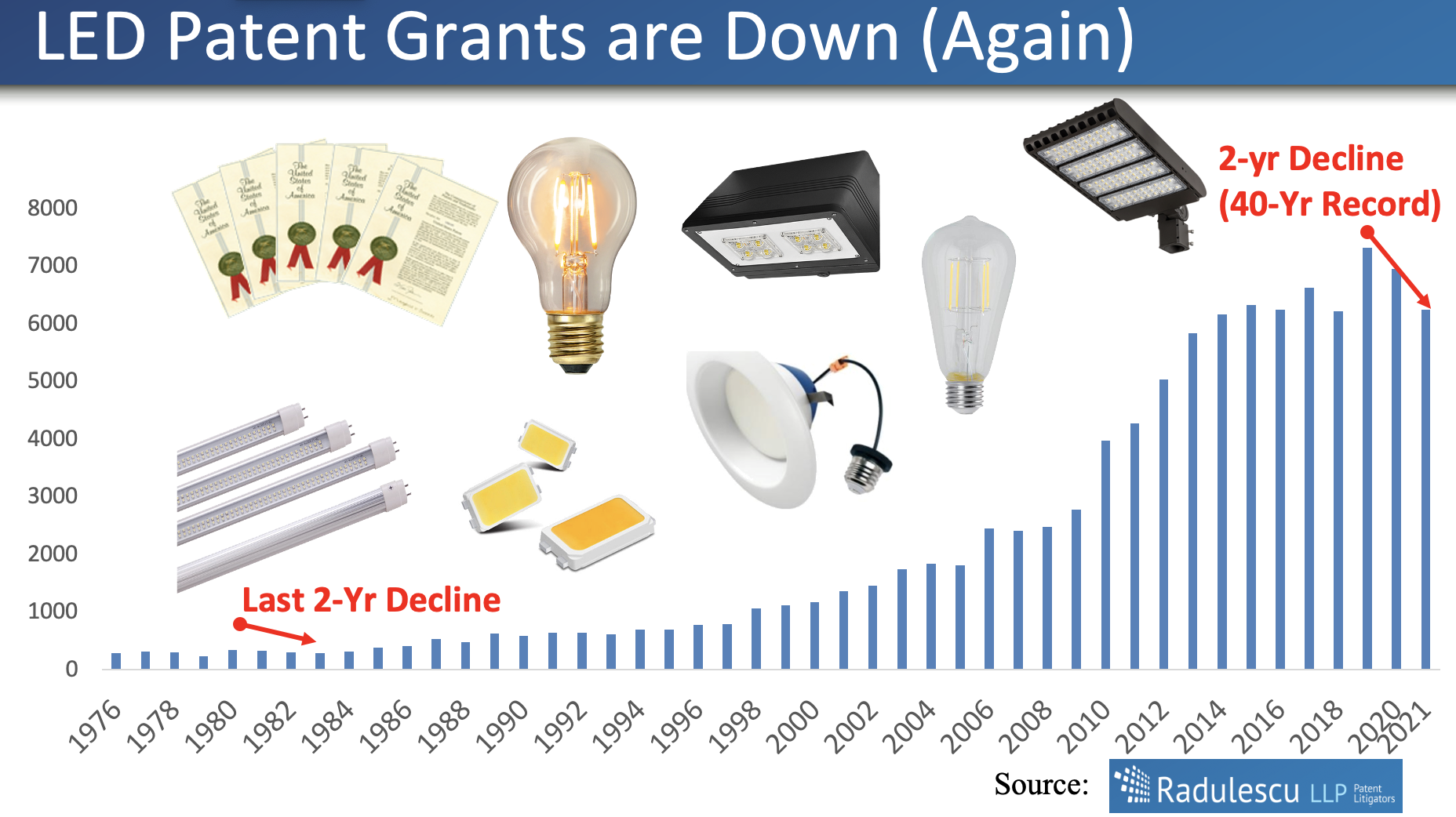
Most of the LED patent assignees in 2021 rest in the display/mobile device realm including top-of-the-heap Samsung with 350 patents. While most of the patents were assigned to firms more closely aligned to displays, tablets, and smartphones, there were a number of lighting companies granted patents in 2021 including, LumiLeds, Seoul Semi, Signify, Osram, Cree, Ideal, Hubbell, LEDVANCE and Ecosense. Of those companies, LumiLeds had the greatest increase from 2020 at 144% with Seoul Semi and Cree at second and third place (+73 and +26%), respectively. Osram, Signify and LEDVANCE had percentage drops from 42-33%.
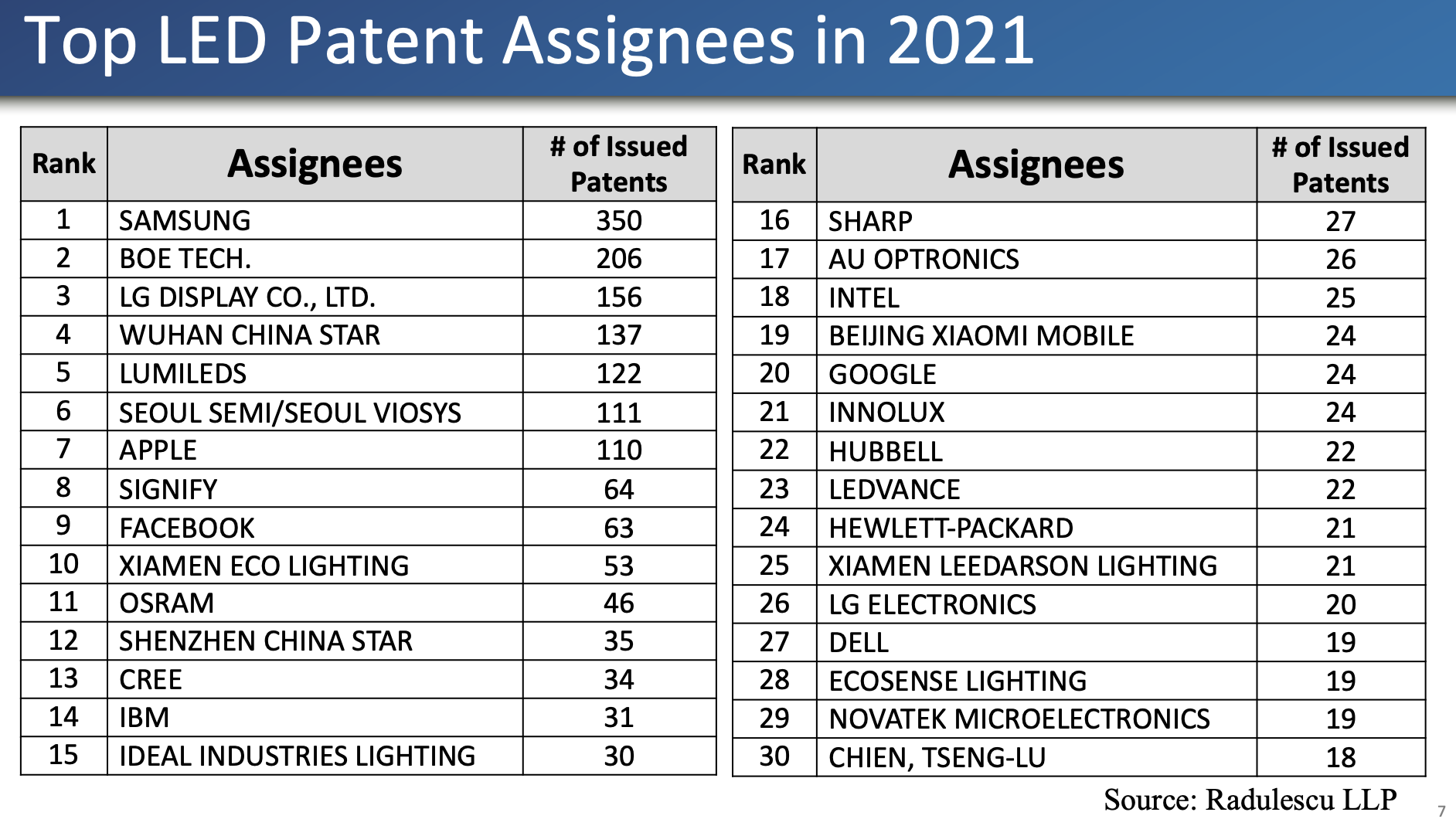
Overall, U.S. patent litigation activity was down slightly from 2020, with 3716 cases filed in 2021 compared to 3739 cases in 2020. 2021 saw the continued shift of cases to the Western District of Texas, with the District of Delaware at number two, and the Eastern District of Texas in third for most popular district court forums. At the PTAB, IPR institution rates climbed slightly to 59% in 2021.
An IPR (inter partes review) is a procedure for challenging the validity of a U.S. patent before the United States Patent and Trademark Office. They have a standard life cycle, which Dr. Radulescu reviewed. 12% of the IPRs are settled out of court within 6 months. By 6 months, 41% are denied and 59% are instituted and move on to trial. Most are resolved by 18 months, with 20% being settled between the parties.
Dr. Radulescu then provided a jaw-dropping deep dive into patent lawsuits currently still active and those settled in one way or another over the last 5 years. Of the 67 LED patent infringement suits initiated in 2018 only 5 are still active. In 2019 the numbers are 76/6, in 2020 92/23 and from 2021 81/50. Notable suits in 2021 include suits brought by Philips/Signify, CAO Lighting, and Kortek Industries, and a number of suits brought by companies looking to license their portfolios, and non-practicing entities.
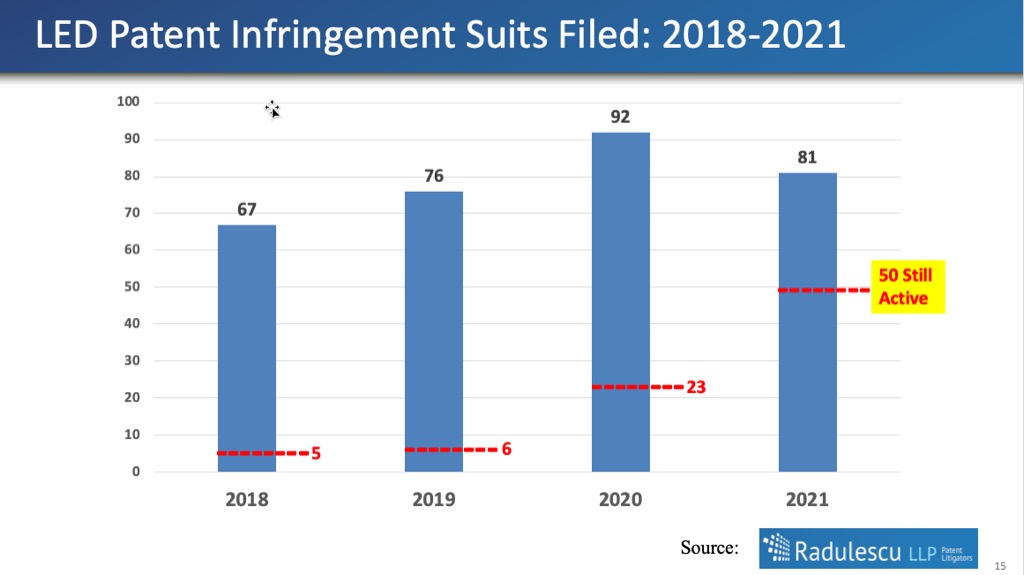
Over the past five years, Signify/Philips’ EnabLED Campaign has continued with the company bringing five suits in 2019 and three in 2021. Signify continued to litigate against one of the ITC respondents it took to trial in 2018, Satco, in a suit in the Eastern District of New York, asserting seven patents (4 old, 3 new). However, that action (and a countersuit brought by Satco) recently concluded. Dr. Radulescu also analyzed the patents that Signify is asserting in its more recent suits and reviewed the recent statistics on the EnabLED licensing program.
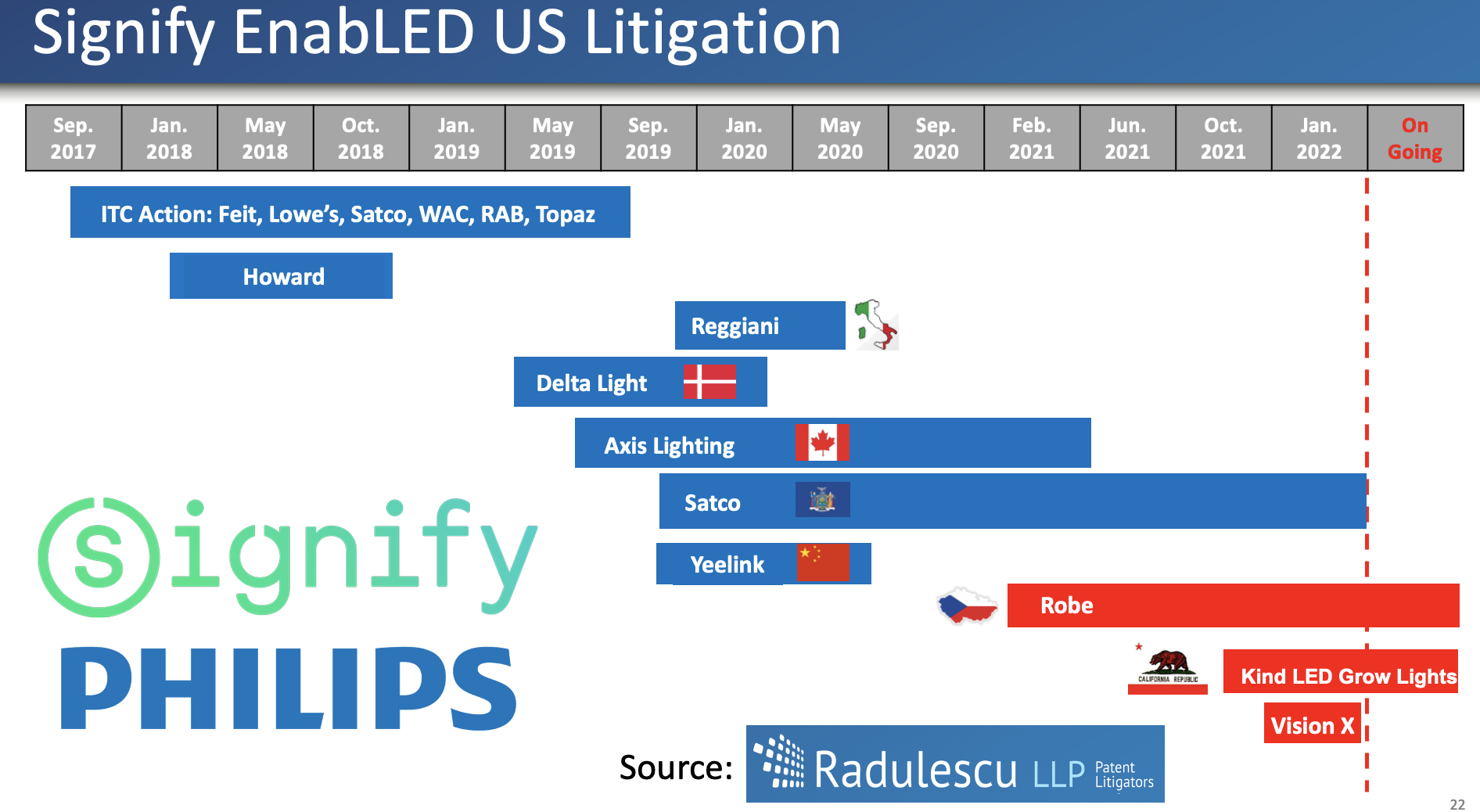
Dr. Radulescu reviewed other notable licensing program campaigns, including Lynk Labs, CAO Lighting, UC Santa Barbara, and Lighting Science Group. After bringing suit against Samsung and Home Depot in the Western District of Texas, Lynk Labs is now litigating in two different forums, as the cases were transferred out of Texas. Together, Home Depot and Samsung filed 23 IPRs, the first two of which were just instituted. In the last year, CAO Lighting expanded its campaign, filing new suits against Topaz, Signify, and Cree, and is currently litigating in Delaware, California, and North Carolina. Dr. Radulescu also reviewed UC Santa Barbara’s and LSG’s recent ITC investigations, which concluded in a finding of no violation by the ALJ. By coincidence, the full ITC issued its opinion on the UC Santa Barbara investigation the day of the webinar, adopting the ALJ’s initial determination of no violation. Dr. Radulescu further provided a review of current non-practicing entity campaigns brought by Bench Walk, Heavy Duty Lighting, LedComm, and LED Wafer Solutions.
Basically, every leader in the LED marketplace is involved in a patent infringement case presently or over the past 5 years. If your head is spinning, let me assure you, you are not alone.
Finally, Dr. Radulescu discussed two case studies of recent cases litigated by Radulescu LLP. In the first, Vaxcel v. HeathCo, Dr. Radulescu discussed how the Radulescu team convinced the court to require claim narrowing after the plaintiff expanded the case to 11 patents and over 160 claims, and how the team had effectively reduced the scope of the case through targeted claim construction disputes (including invalidating 6 of 11 patents in the process, i.e. over 60% of the asserted claims). In the second, Dr. Radulescu discussed how the firm helped its client WAC Lighting enforce its patents in the ITC against three competitors, resulting in all three companies agreeing to stop selling/importing the accused products. This investigation was the only successful ITC enforcement of LED patents directed to residential lights/fixtures in the last 5 years.
There are so many moving pieces and players, it is impossible to keep score without the help of programs like Dr. Radulescu’s webinar.
For more information on the presentation feel free to contact Radulescu LLP.

